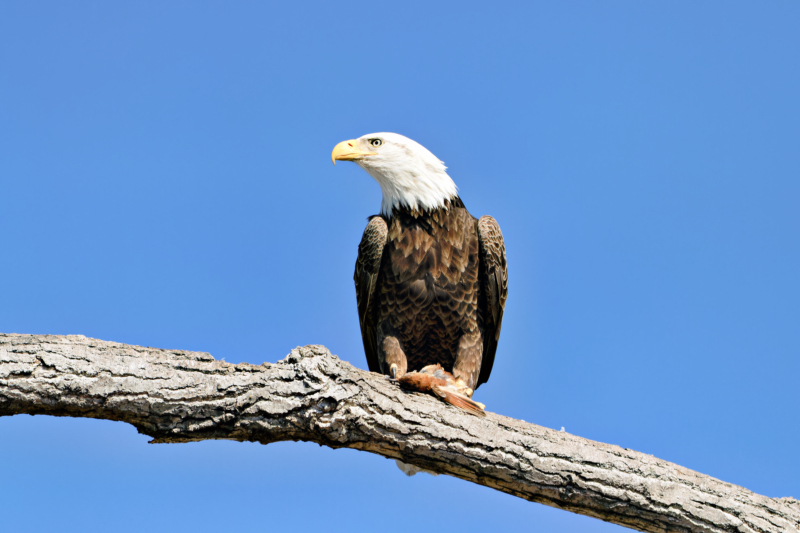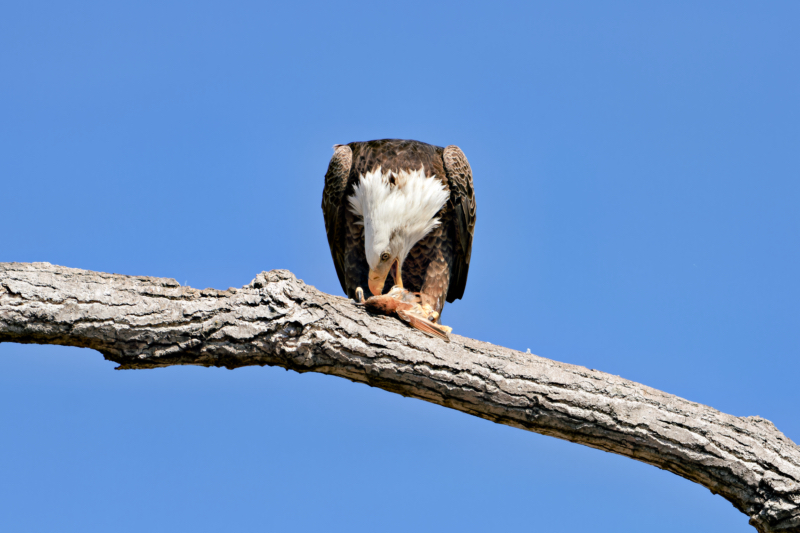During a visit to the Sequoyah National Wildlife Refuge in Oklahoma, I photographed a Bald Eagle perched on a large cottonwood limb above the auto tour road. It was feasting on a bird. Based on its markings, the prey appears to be a Brown Thrasher.
Bald Eagles: Opportunistic Hunters
While Bald Eagles are best known for their fish-heavy diet, they occasionally turn to birds as an alternative food source. Their predation of songbirds may not be widely discussed, but it plays a crucial role in maintaining ecological balance.
When and Why Bald Eagles Prey on Songbirds
- Opportunistic Strategy: Rather than engaging in high-speed chases, Bald Eagles take advantage of vulnerable songbirds. They may target fledglings leaving the nest, birds weakened by extreme weather, or those caught near a scavenging site.
- Size Preferences: Smaller songbirds such as robins, jays, and swallows are more likely targets. However, larger eagles, like Golden Eagles, have been observed preying on crows and even small turkeys.
- Kleptoparasitism: This refers to a behavior where one animal steals food from another. In some cases, Bald Eagles prefer theft over hunting. They have been known to snatch songbirds from hawks mid-air, capitalizing on another predator’s efforts.
- Seasonal Adjustments: During winter, when fish are less abundant, songbird predation may slightly increase as eagles adapt to available food sources.
- Regional Specialization: Certain eagle populations adapt to their local environment by preying on specific bird species. For instance, some Bald Eagles in Florida specialize in catching clapper rails from the marshes.

Bald Eagles and Songbirds in the Ecosystem Balance
While the idea of Bald Eagles preying on songbirds may seem harsh, it serves a natural function. Their presence helps regulate songbird populations, preventing overpopulation and maintaining a stable ecosystem.
Conservation Interconnection
The decline of songbird populations due to habitat destruction can indirectly affect Bald Eagles. With fewer songbirds available as prey, eagles may resort to hunting already endangered fish species, such as the pallid sturgeon and certain populations of salmon. This shift in diet could further stress these vulnerable fish populations, impacting conservation efforts for multiple species.
Photography Details
- Camera: Canon 7D
- Lens: Canon EF 500mm f/4L IS
- Location: Sequoyah National Wildlife Refuge, Oklahoma
- Date & Time: February 12, 2014, at 2:47 P.M.
- Aperture: f/5.0
- Shutter Speed: 1/6400 sec
- ISO: 640
- Exposure Compensation: -2/3
- Focal Length: 500mm
Additional Resources
For more in-depth information on Bald Eagles, their diet, and behavior, visit Cornell Lab of Ornithology – Bald Eagle Overview.
Final Thoughts
This rare observation highlights the adaptability of Bald Eagles and their ability to exploit various food sources. While fish remain their primary diet, their occasional predation on songbirds demonstrates their opportunistic hunting strategies. This behavior plays a role in maintaining ecological balance and underscores the interconnectedness of different species within their habitat. Their adaptability allows them to thrive in diverse conditions, further emphasizing their resilience as top predators in the avian world.
